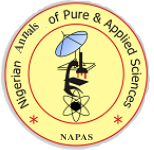Evaluation of Perma Net® 2.0 in the Control of Culex quinquefasciatus and Aedes aegypti from Awka, Anambra State, Nigeria
DOI:
Keywords:
Culex quinquefasciatus, Aedes aegypti, Perma Net® 2.0, LLINs, Mortality, RepellencyAbstract
Long Lasting Insecticide Nets (LLINs) reduce human-mosquito contact through the provision of physical barrier, repellent effect or mortality effect. This study evaluated the physical integrity and residual effect of insecticides in Perma Net® 2.0 of 6 months, 1 year, 2 years, 3 years and 4 years duration of use. Perma Net®2.0 used were obtained from systematically picked households within Ifite Awka and new Perma Net® 2.0 serving as control were collected from Society for Family Health. Adult mosquitoes were collected from picked households using Pyrethrum knockdown Collection method before the Perma Net® 2.0 were removed. The top and four sides of the nets were examined for presence of holes. Also, net pieces measuring 25cm × 25cm were obtained from Perma Net® 2.0 of different duration and subjected to WHO cone bioassay using Randomized Block Experimental Design. The Culex quinquefasciatus and Aedes aegypti used for the bioassay were collected from breeding sites within Ifite Awka, reared and maintained in an insectary. There was at least one hole in 10%, 30% and 40% of LLINs with 2 years, 3years and 4 years duration of use respectively. Significant differences were found in the physical integrity of the nets (P < 0.05). Culex
quinquefasciatus and Aedes aegypti constituted 40.9% and 27.0% of all mosquitoes collected indoors respectively. There was no significant difference in the indoor abundance of the two mosquito species (P >0.05). However, their abundance depended on the duration of LLINs usage (P < 0.05). The mortality effects of
16%, 8%, 7%, 5%, 5% and 2% on Culex quinquefasciatus were recorded for Perma Net® 2.0 of 0 month, 6 months, 1 year, 2 years, 3 years and 4 years respectively. The mortality effects of 23%, 12%, 9%, 6%, 5% and 3% on Aedes aegypti were recorded for Perma Net® 2.0 of 0 month, 6 months, 1 year, 2 years, 3 years and 4
years respectively. The new LLINs produced significantly highest mortality effect (P < 0.05) on both mosquito species than nets of other duration of usage. The mortality effect of Perma Net® 2.0 on Culex quinquefasciatus, and that on Aedes aegypti were similar (P > 0.05). It shows that Perma Net® 2.0 offer physical barrier more than repellency and mortality effect against Culex quinquefasciatus, and Aedes aegypti.



 Contact Us
Contact Us Editorial Team
Editorial Team Join As A Reviewer
Join As A Reviewer  Request For Print Copy
Request For Print Copy


 Cprint Publishers
Cprint Publishers